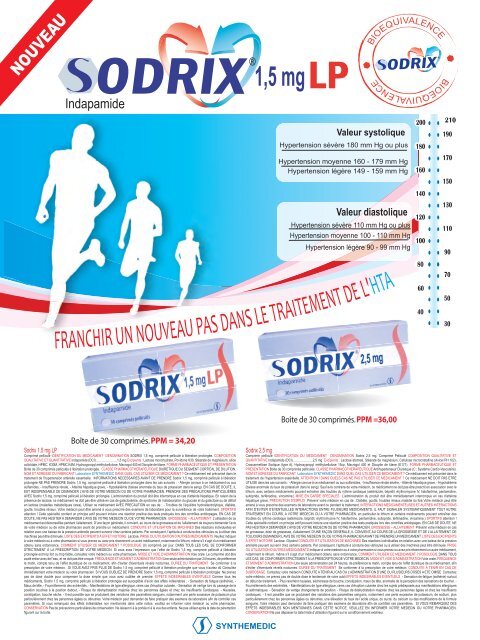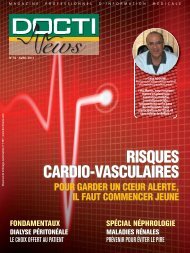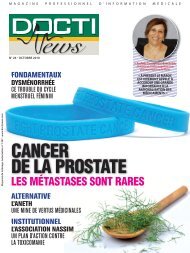qu'en est-il de la logistique médicale - Doctinews
qu'en est-il de la logistique médicale - Doctinews
qu'en est-il de la logistique médicale - Doctinews
Create successful ePaper yourself
Turn your PDF publications into a flip-book with our unique Google optimized e-Paper software.
NOUVEAU<br />
Boîte <strong>de</strong> 30 comprimés. PPM = 34,20<br />
Valeur systolique<br />
Hypertension sévère 180 mm Hg ou plus<br />
Hypertension moyenne 160 - 179 mm Hg<br />
Hypertension légère 149 - 159 mm Hg<br />
Valeur diastolique<br />
Hypertension sévère 110 mm Hg ou plus<br />
Hypertension moyenne 100 - 110 mm Hg<br />
Hypertension légère 90 - 99 mm Hg<br />
FRANCHIR UN NOUVEAU PAS DANS LE TRAITEMENT DE L'HTA<br />
Sodrix 1.5 mg LP<br />
Comprimé pelliculé IDENTIFICATION DU MEDICAMENT DENOMINATION SODRIX 1,5 mg, comprimé pelliculé à libération prolongée. COMPOSITION<br />
QUALITATIVE ET QUANTITATIVE Indapami<strong>de</strong> (DCI)…………………1,5 mg Excipients : Lactose monohydrate, Povidone K30, Stéarate <strong>de</strong> magnésium, s<strong>il</strong>ice<br />
colloïdale, HPMC K30M, HPMC K4M, Hydroxypropyl méthylcellulose, Macrogol 400 et Dioxy<strong>de</strong> <strong>de</strong> titane. FORME PHARMACEUTIQUE ET PRESENTATION<br />
Boîte <strong>de</strong> 30 comprimés pelliculés à libération prolongée. CLASSE PHARMACOTHERAPEUTIQUE DIURETIQUE DU SEGMENT CORTICAL DE DILUTION.<br />
NOM ET ADRESSE DU FABRICANT Laboratoire SYNTHEMEDIC DANS QUEL CAS UTILISER CE MÉDICAMENT ? Ce médicament <strong>est</strong> préconisé dans le<br />
traitement <strong>de</strong> l’hypertension artérielle essentielle. INFORMATIONS NECESSAIRES AVANT DE PRENDRE Sodrix 1,5 mg, comprimé pelliculé à libération<br />
prolongée NE PAS PRENDRE Sodrix 1,5 mg, comprimé pelliculé à libération prolongée dans les cas suivants : - Allergie connue à ce médicament ou aux<br />
sulfami<strong>de</strong>s, - Insuffisance rénale, - Atteinte hépatique grave, - Hypokaliémie (baisse anormale du taux <strong>de</strong> potassium dans le sang). EN CAS DE DOUTE, IL<br />
EST INDISPENSABLE DE DEMANDER L’AVIS DE VOTRE MEDECIN OU DE VOTRE PHARMACIEN. PRENDRE DES PRÉCAUTIONS PARTICULIÈRES<br />
AVEC Sodrix 1,5 mg, comprimé pelliculé à libération prolongée. L’administration du produit doit être interrompue en cas d’atteinte hépatique. En raison <strong>de</strong> <strong>la</strong><br />
présence <strong>de</strong> <strong>la</strong>ctose, ce médicament ne doit pas être ut<strong>il</strong>isé en cas <strong>de</strong> ga<strong>la</strong>ctosémie, <strong>de</strong> syndrome <strong>de</strong> ma<strong>la</strong>bsorption du glucose et du ga<strong>la</strong>ctose ou <strong>de</strong> déficit<br />
en <strong>la</strong>ctose (ma<strong>la</strong>dies métaboliques rares). Ut<strong>il</strong>iser ce médicament AVEC PRECAUTION en cas <strong>de</strong> : - Troubles <strong>de</strong> l’équ<strong>il</strong>ibre hydroélectrolytique, diabète,<br />
goutte, troubles rénaux. Votre mé<strong>de</strong>cin peut être amené à vous prescrire <strong>de</strong>s examens <strong>de</strong> <strong>la</strong>boratoire pour <strong>la</strong> surve<strong>il</strong><strong>la</strong>nce <strong>de</strong> votre traitement. SPORTIFS<br />
attention ! Cette spécialité contient un principe actif pouvant induire une réaction positive <strong>de</strong>s t<strong>est</strong>s pratiqués lors <strong>de</strong>s contrôles antidopages. EN CAS DE<br />
DOUTE, NE PAS HESITER A DEMANDER L’AVIS DE VOTRE MEDECIN OU DE VOTRE PHARMACIEN. GROSSESSE – ALLAITEMENT L’ut<strong>il</strong>isation <strong>de</strong> ce<br />
médicament <strong>est</strong> déconse<strong>il</strong>lée pendant l’al<strong>la</strong>itement. D’une façon générale, <strong>il</strong> convient, au cours <strong>de</strong> <strong>la</strong> grossesse et <strong>de</strong> l’al<strong>la</strong>itement <strong>de</strong> toujours <strong>de</strong>man<strong>de</strong>r l’avis<br />
<strong>de</strong> votre mé<strong>de</strong>cin ou <strong>de</strong> votre pharmacien avant <strong>de</strong> prendre un médicament. CONDUITE ET UTILISATION DE MACHINES Des réactions individuelles en<br />
re<strong>la</strong>tion avec une baisse <strong>de</strong> <strong>la</strong> pression artérielle peuvent survenir chez certains patients. Par conséquent, l’aptitu<strong>de</strong> à conduire <strong>de</strong>s véhicules ou à ut<strong>il</strong>iser <strong>de</strong>s<br />
machines peut être diminuée. LISTE DES EXCIPIENTS À EFFET NOTOIRE Lactose. PRISE OU UTILISATION D’AUTRES MEDICAMENTS Veu<strong>il</strong>lez indiquer<br />
à votre mé<strong>de</strong>cin ou à votre pharmacien si vous prenez ou avez pris récemment un autre médicament, notamment le lithium, même s’<strong>il</strong> s’agit d’un médicament<br />
obtenu sans ordonnance. COMMENT UTILISER CE MEDICAMENT ? POSOLOGIE Un comprimé par jour. DANS TOUS LES CAS, SE CONFORMER<br />
STRICTEMENT À LA PRESCRIPTION DE VOTRE MEDECIN. Si vous avez l’impression que l’effet <strong>de</strong> Sodrix 1,5 mg, comprimé pelliculé à libération<br />
prolongée <strong>est</strong> trop fort ou trop faible, consultez votre mé<strong>de</strong>cin ou votre pharmacien. MODE ET VOIE D’ADMINISTRATION Voie orale. Le comprimé doit être<br />
avalé entier avec <strong>de</strong> l’eau, et ne doit pas être croqué. FREQUENCE ET MOMENT D’ADMINISTRATION Une seule administration par 24 heures, <strong>de</strong> préférence<br />
le matin, compte tenu <strong>de</strong> l’effet diurétique <strong>de</strong> ce médicament, afin d’éviter d’éventuels réve<strong>il</strong>s nocturnes. DUREE DU TRAITEMENT Se conformer à <strong>la</strong><br />
prescription <strong>de</strong> votre mé<strong>de</strong>cin. SI VOUS AVEZ PRIS PLUS DE Sodrix 1,5 mg, comprimé pelliculé à libération prolongée que vous n’auriez dû Consultez<br />
immédiatement votre mé<strong>de</strong>cin ou votre pharmacien. SI VOUS OUBLIEZ DE PRENDRE Sodrix 1,5 mg, comprimé pelliculé à libération prolongée Ne prenez<br />
pas <strong>de</strong> dose double pour compenser <strong>la</strong> dose simple que vous avez oubliée <strong>de</strong> prendre. EFFETS INDESIRABLES EVENTUELS Comme tous les<br />
médicaments, Sodrix 1,5 mg, comprimé pelliculé à libération prolongée <strong>est</strong> susceptible d’avoir <strong>de</strong>s effets indésirables : - Sensation <strong>de</strong> fatigue (asthénie), -<br />
Maux <strong>de</strong> tête, - Fourm<strong>il</strong>lements <strong>de</strong>s extrémités, - Manif<strong>est</strong>ations <strong>de</strong> type allergique, rares cas d’éruption cutanée, - Sensation <strong>de</strong> vertige lors du passage <strong>de</strong> <strong>la</strong><br />
position couchée à <strong>la</strong> position <strong>de</strong>bout, - Risque <strong>de</strong> déshydratation majorée chez les personnes âgées et chez les insuffisants Cardiaques. - Nausées,<br />
constipation, bouche sèche. - Il <strong>est</strong> possible que se produisent <strong>de</strong>s variations <strong>de</strong>s paramètres sanguins, notamment une perte excessive <strong>de</strong> potassium plus<br />
particulièrement chez les personnes âgées ou dénutries. Votre mé<strong>de</strong>cin peut <strong>de</strong>man<strong>de</strong>r <strong>de</strong> faire pratiquer <strong>de</strong>s examens <strong>de</strong> <strong>la</strong>boratoire afin <strong>de</strong> contrôler ces<br />
paramètres. Si vous remarquez <strong>de</strong>s effets indésirables non mentionnés dans cette notice, veu<strong>il</strong>lez en informer votre mé<strong>de</strong>cin ou votre pharmacien.<br />
CONSERVATION Pas <strong>de</strong> précautions particulières <strong>de</strong> conservation. Ne <strong>la</strong>isser ni à <strong>la</strong> portée ni à <strong>la</strong> vue <strong>de</strong>s enfants. Ne pas ut<strong>il</strong>iser après <strong>la</strong> date <strong>de</strong> péremption<br />
figurant sur <strong>la</strong> boîte.<br />
Boîte <strong>de</strong> 30 comprimés. PPM =36,00<br />
200<br />
180<br />
160<br />
140<br />
120<br />
100<br />
80<br />
210<br />
Sodrix 2,5 mg<br />
Comprimé pelliculé IDENTIFICATION DU MEDICAMENT DENOMINATION Sodrix 2,5 mg, Comprimé Pelliculé COMPOSITION QUALITATIVE ET<br />
QUANTITATIVE Indapami<strong>de</strong> (DCI)………………..2,5 mg Excipients : Lactose atomisé, Stéarate <strong>de</strong> magnésium, Cellulose microcristalline (Avicel PH 102),<br />
Croscarmellose Sodique (type A), Hydroxypropyl méthylcellulose 15cp, Macrogol 400 et Dioxy<strong>de</strong> <strong>de</strong> titane (E171). FORME PHARMACEUTIQUE ET<br />
PRESENTATION Boîte <strong>de</strong> 30 comprimés pelliculés. CLASSE PHARMACOTHERAPEUTIQUE Antihypertenseur Diurétique (C : Système Cardio-Vascu<strong>la</strong>ire).<br />
NOM ET ADRESSE DU FABRICANT Laboratoire SYNTHEMEDIC DANS QUEL CAS UTILISER CE MEDICAMENT ? Ce médicament <strong>est</strong> préconisé dans le<br />
traitement <strong>de</strong> l’hypertension essentielle. ATTENTION ! DANS QUELS CAS NE PAS UTILISER CE MEDICAMENT ? Ce médicament NE DOIT PAS ETRE<br />
UTILISE dans les cas suivants : - Allergie connue à ce médicament ou aux sulfami<strong>de</strong>s, - Insuffisance rénale sévère, - Atteinte hépatique grave, - Hypokaliémie<br />
(baisse anormale du taux <strong>de</strong> potassium dans le sang). Sauf avis contraire <strong>de</strong> votre mé<strong>de</strong>cin, ce médicament ne doit pas être prescrit en association avec le<br />
lithium, avec certains médicaments pouvant entraîner <strong>de</strong>s troubles du rythme cardiaque (astémizole, béprid<strong>il</strong>, érythromycine IV, halofantrine, pentamidine,<br />
sultopri<strong>de</strong>, terfénadine, vincamine.) MISE EN GARDE SPECIALES L’administration du produit doit être immédiatement interrompue en cas d’atteinte<br />
hépatique grave. PRECAUTION D’EMPLOI Prévenir votre mé<strong>de</strong>cin en cas <strong>de</strong> : Diabète, goutte, troubles rénaux ma<strong>la</strong>die du foie Votre mé<strong>de</strong>cin peut être<br />
amené à vous prescrire <strong>de</strong>s examens <strong>de</strong> <strong>la</strong>boratoire avant ou pendant le traitement. INTERACTIONS MEDICAMENTEUSES ET AUTRES INTERACTIONS<br />
AFIN D’EVITER D’EVENTUELLES INTERACTIONS ENTRE PLUSIEURS MEDICAMENTS, IL FAUT SIGNALER SYSTEMATIQUEMENT TOUT AUTRE<br />
TRAITEMENT EN COURS, A VOTRE MEDECIN OU A VOTRE PHARMACIEN, en particulier le lithium et certains médicaments pouvant entraîner <strong>de</strong>s<br />
troubles du rythme cardiaque (astémizole, béprid<strong>il</strong>, érythromycine IV, halofantrine, pentamidine, sultopri<strong>de</strong>, terfénadine, vincamine.) SPORTIFS attention !<br />
Cette spécialité contient un principe actif pouvant induire une réaction positive <strong>de</strong>s t<strong>est</strong>s pratiqués lors <strong>de</strong>s contrôles antidopages. EN CAS DE DOUTE, NE<br />
PAS HESITER A DEMANDER L’AVIS DE VOTRE MEDECIN OU DE VOTRE PHARMACIEN. GROSSESSE – ALLAITEMENT Prévenir votre mé<strong>de</strong>cin en cas<br />
<strong>de</strong> grossesse, désir <strong>de</strong> grossesse, d’al<strong>la</strong>itement. D’UNE FAÇON GENERALE, IL CONVIENT, AU COURS DE LA GROSSESSE ET DE L’ALLAITEMENT, DE<br />
TOUJOURS DEMANDER L’AVIS DE VOTRE MEDECIN OU DE VOTRE PHARMACIEN AVANT DE PRENDRE UN MEDICAMENT. LISTE DES EXCIPIENTS<br />
À EFFET NOTOIRE Lactose. Glycérol CONDUITE ET UTILISATION DE MACHINES Des réactions individuelles en re<strong>la</strong>tion avec une baisse <strong>de</strong> <strong>la</strong> pression<br />
artérielle peuvent survenir chez certains patients. Par conséquent, l’aptitu<strong>de</strong> à conduire <strong>de</strong>s véhicules ou à ut<strong>il</strong>iser <strong>de</strong>s machines peut être diminuée. PRISE<br />
OU UTILISATION D’AUTRES MEDICAMENTS Indiquer à votre mé<strong>de</strong>cin ou à votre pharmacien si vous prenez ou avez pris récemment un autre médicament,<br />
notamment le lithium, même s’<strong>il</strong> s’agit d’un médicament obtenu sans ordonnance. COMMENT UTILISER CE MEDICAMENT ? POSOLOGIE DANS TOUS<br />
LES CAS, SE CONFORMER STRICTEMENT À LA PRESCRIPTION DE VOTRE MEDECIN. MODE ET VOIE D’ADMINISTRATION Voie orale. FREQUENCE<br />
ET MOMENT D’ADMINISTRATION Une seule administration par 24 heures, <strong>de</strong> préférence le matin, compte tenu <strong>de</strong> l’effet diurétique <strong>de</strong> ce médicament, afin<br />
d’éviter d’éventuels réve<strong>il</strong>s nocturnes. DUREE DU TRAITEMENT Se conformer à <strong>la</strong> prescription <strong>de</strong> votre mé<strong>de</strong>cin. CONDUITE À TENIR EN CAS DE<br />
SURDOSAGE Contactez votre mé<strong>de</strong>cin CONDUITE A TENIR AU CAS OU L’ADMINISTRATION D’UNE OU PLUSIEURS DOSES A ETE OMISE Contactez<br />
votre mé<strong>de</strong>cin, ne prenez pas <strong>de</strong> double dose le len<strong>de</strong>main <strong>de</strong> votre oubli.EFFETS INDESIRABLES EVENTUELS - Sensation <strong>de</strong> fatigue (asthénie) surtout<br />
en début <strong>de</strong> traitement. - Plus rarement nausées, sécheresse <strong>de</strong> bouche, constipation, maux <strong>de</strong> tête, anomalie <strong>de</strong> <strong>la</strong> perception <strong>de</strong>s sensations <strong>de</strong> toucher. -<br />
Fourm<strong>il</strong>lements <strong>de</strong>s extrémités. - Manif<strong>est</strong>ations <strong>de</strong> type allergique, rares cas d’éruption cutanée chez les sujets prédisposés aux manif<strong>est</strong>ations allergiques<br />
et asthmatiques. - Sensation <strong>de</strong> vertige changements <strong>de</strong> position. - Risque <strong>de</strong> déshydratation majorée chez les personnes âgées et chez les insuffisants<br />
cardiaques. - Il <strong>est</strong> possible que se produisent <strong>de</strong>s variations <strong>de</strong>s paramètres sanguins, notamment une perte excessive <strong>de</strong> potassium, <strong>de</strong> sodium, plus<br />
particulièrement chez les personnes âgées ou dénutries, une élévation du taux <strong>de</strong> l’aci<strong>de</strong> urique, du sucre, du calcium ou <strong>de</strong>s modifications <strong>de</strong> <strong>la</strong> formule<br />
sanguine. Votre mé<strong>de</strong>cin peut <strong>de</strong>man<strong>de</strong>r <strong>de</strong> faire pratiquer <strong>de</strong>s examens <strong>de</strong> <strong>la</strong>boratoire afin <strong>de</strong> contrôler ces paramètres. SI VOUS REMARQUEZ DES<br />
EFFETS INDESIRABLES NON MENTIONNES DANS CETTE NOTICE, VEUILLEZ EN INFORMER VOTRE MEDECIN OU VOTRE PHARMACIEN.<br />
CONSERVATION Ne pas dépasser <strong>la</strong> date limite d’ut<strong>il</strong>isation figurant sur le conditionnement extérieur.<br />
SYNTHEMEDIC<br />
BIOEQUIVALENCE<br />
BIOEQUIVALENCE<br />
60<br />
40<br />
190<br />
170<br />
150<br />
130<br />
110<br />
90<br />
70<br />
50<br />
30








